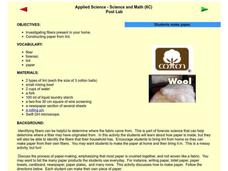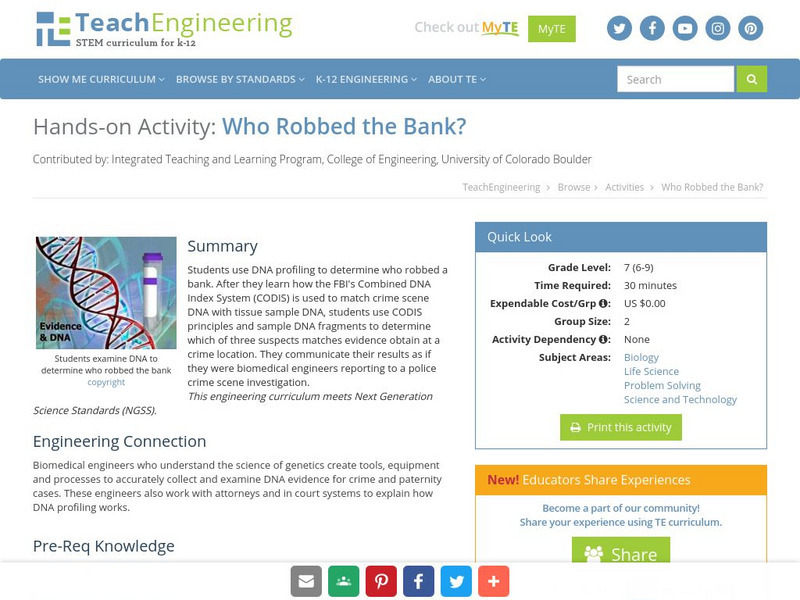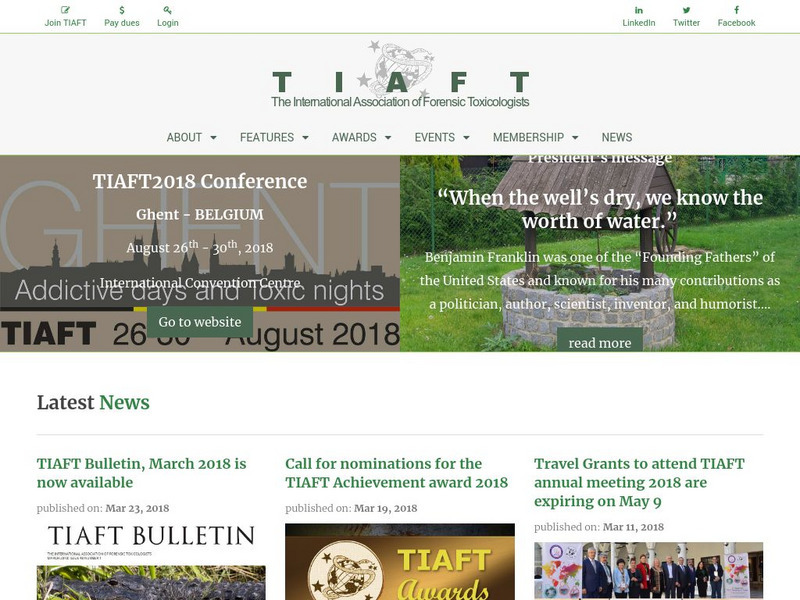Curated OER
Close Encounters
Young scholars investigate the cause of death of a fictitious school janitor. They develop hypotheses based on information discovered by examining the labels of household chemicals.
Curated OER
Applied Science - Science and Math Post Lab
Students construct paper. In this applied Science lesson, students create paper using lint. Students investigate the different fibers in their homes.
Curated OER
Who Is It?/Who Done It?
Students conduct an experiment that allows them to assess individual differences in random DNA sequences and apply those differences when solving a forensic problem. After discussing the polymerase chain reaction and its use to identify...
Curated OER
Hunt for the Serial Arsonist
Students prepare study, and graph fingerprint patterns. They create latent fingerprints and look for common features in their prints for classification.In addition, they create a graph showing the distribution of different patterns...
Curated OER
Culture Clash: New World Meets Old
Sixth graders explore the history of Christopher Columbus. In this World History lesson, 6th graders research facts about Christopher Columbus. Students write their own opinion about Columbus's background focusing on three piecesof...
Curated OER
Wanted - Butch and Sundance
Students explore forensic anthropology. Given data, students determine which bones might have been the remains of which individual. They discuss how scientists work with inconclusive data.
Curated OER
Blood Business
Young scholars identify the different kinds of blood. In this biology lesson, students investigate the antigens, agglutinins and Rh factor using their own blood. They use Punnett squares to predict blood type of offspring.
Curated OER
Blood, I Presume?
Students explain the value of blood in trials. In this DNA lesson students work together to collect and share information and ideas that they come up with after learning how to distinguish blood from other stains.
TeachEngineering
Teach Engineering: Who Robbed the Bank?
Students use DNA profiling to determine who robbed a bank. After they learn how the FBI's Combined DNA Index System (CODIS) is used to match crime scene DNA with tissue sample DNA, students use CODIS principles and sample DNA fragments...
University of Kansas Medical Center
Univ of Kansas Medical Center: Careers in Human Genetics
This site from the University of Kansas Medical Center provides an excellent list of resources for additional information about careers in genetics.
Museum of Science
Museum of Science and Industry: Online Science: Identify Your Fingerprints
Become a forensic investigator, and follow these simple step-by-step instructions to take, examine, and identify your fingerprints.
Oak Ridge National Laboratory
Oak Ridge National Laboratory: Dna Forensics
A concise explanation of the use of DNA technologies in forensic identification from the Oak Ridge National Laboratory. Additional valuable resources are provided.
Other
Tech Museum of Innovation: Forensics
This is part of the overview page for the online exhibit on Genetics from the Tech Museum of Innovation. This particular section focuses on forensic science and its work with modern crime detection.
Other
International Association of International Toxicologists
The aims of this TIAFT are to promote cooperation and coordination of efforts among members and to encourage research in forensic toxicology. The members come from police forces, medical examiners and coroners' laboratories, horseracing...
Other
Teachers First: Lessons: Who Did It? Forensics to Hone Science and Lab Skills
Comprehensive twenty-activity unit, complete with a WebQuest and assessment materials, designed to introduce forensic science to middle schoolers in grades 6, 7, and 8.















